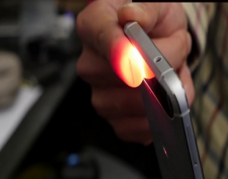
Computer scientist Shwetak Patel and his team are developing new sensing systems. The first focus was really around energy and water monitoring. They built a new generation of smart sensors that monitor electronic interference(干扰) on a home’s power line or water pressure changes in the system of pipes. Most of this technology has already found industrial applications. And Patel and his team turned their attention to adapting the technology for personal health monitoring.
“So how do we take this noise and make it into a signal of interest? That was a kind of the core of what we did for many years. And we’re taking that work and applying it to other fields.” said Patel. They’re looking to take advantage of all the practicality built into the smart phones. With the users’ permission, this app can use the microphone, built into most smart phones, to listen to background noises, such as coughing. “It will suggest you a trip to the doctor if necessary. We construct these models and try to understand how sound works. And we give it lots of examples of different kinds of sounds, like people talking, laughing, sneezing and of course coughing.”
This app also uses a phone’s camera to check haemoglobin(血红蛋白) levels in blood by analyzing the color of blood through the skin. Generally speaking, if you’re anemic, in other words, you have too few red cells in your blood, it is going to be a little less red. We take advantage of that by putting your finger over a camera of a phone. The camera of the phone can actually see the natural colors of the blood. In this way can a first-time parent learn about the level of jaundice(黄疸) in a newborn infant.
Researchers say the built-in sensors found in smart phones are already commonplace but their applications and their implications for our health and well-being may be more far-reaching than we ever imagined.
本时文内容由奇速英语国际教育研究院原创编写,未经书面授权,禁止复制和任何商业用途,版权所有,侵权必究!(投稿及合作联系:028-84400718 QQ:757722345)
1.What was Shwetak Patel and his team’s original purpose?
A To make a new power line.
B To change the water pressure.
C To monitor water and energy.
D To help with personal health.
解析:选C。C 细节理解题。根据第一段的“The first focus was really around energy and water monitoring.”可知他们最初聚焦于监测能源和水质。故选C。
2.The App might advise people to see the doctor through their sound of _________.
A talking
B laughing
C sneezing
D coughing
解析:选D。D细节理解题。根据第二段的“to listen to background noises, such as coughing. It will suggest you a trip to the doctor if necessary.”可知手机的麦克风通过听人的咳嗽声来提示他们应该去看医生,故选D。
3.What does the underlined word “anemic” mean in Chinese?
A 充血的.
B 贫血的.
C 流血的.
D 止血的.
解析:选B。B 词义猜测题。根据划线词后面的内容“in other words, you have too few red cells in your blood, it is going to be a little less red”也就是说你的血液里的红细胞很少,血液的颜色就没有那么红,由此推断应该是贫血的症状。故选B。
4.What’s the text mainly about?
A A computer scientist.
B An industrial monitor.
C A new health app.
D A research on jaundice.
解析:选C。C 主旨大意题。文章第一段最后一句引入文章的主旨:把新一代的智能传感器技术用于进行个人健康监测。第二三段主要介绍了用传感器技术研发出一款可安装于智能手机里的app。故选C。